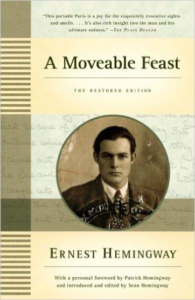
A Moveable Feast
By Ernest Hemingway
1st ed. published in 1964 by Charles Scribner’s Sons
2nd “Restored” ed. published in 2009 by Seán Hemingway
223 pages (1964); 256 pages (2009)
This was the second time I read A Moveable Feast. Well, I didn’t read it this time, I listened to it. And I’m glad I did.
As my brother Andrew once told me, one can argue that Ernest Hemingway was one of the two most important prose stylists in English of the 20th century. (I don’t remember who he said the other one was.) Listening to this memoir of his years as a struggling journalist/ writer in Paris during the 1920s made me a believer. You really cannot appreciate how powerful and poetic Hemingway’s language is until you hear it read aloud.
If you are at all interested in the luminaries of literature during this time period, this book is what it claims to be: a literary feast of the most colorful characters of the Lost Generation. Here you will be introduced to the wit and eccentricities of F. Scott and Zelda Fitzgerald, Ford Madox Ford, James Joyce, Wyndham Lewis, Ezra Pound, and Gertrude Stein, along with artists like Jules Pascin, and Sylvia Beach, the proprietor of the legendary Shakespeare & Company bookstore.
Hemingway died in 1961, before the book was published, leaving some question as to whether he had finished it. It was published posthumously in 1964 by Hemingway’s fourth wife and widow, Mary, based upon his original manuscripts and notes. But a second edition was published in 2009 by his grandson Seán Hemingway, who felt that Mary’s edition had been incorrectly altered to suit her version of his life at that time.
There is ongoing controversy in literary circles over which edition – if either – can be considered the book Hemingway intended.
Critical Reviews for the 1964 Edition
* “Here is Hemingway at his best. No one has ever written about Paris in the 1920s as well as Hemingway.” (Charles Poore in The New York Times)
* “The reader of… A Moveable Feast, who, of course already knows a lot about Hemingway, quickly suspects that whatever may have been the original facts behind Hemingway’s ruptures with Gertrude Stein, F. Scott Fitzgerald, Ford Madox Ford, and Hadley Richardson (the first Mrs. Hemingway), he will never get them here. The book is too splendidly, too artfully written; the chapters are sketches and anecdotes often as fine in their texture as Hemingway’s famous stories; the dialogue is too witty; and the real plot of the book – a young writer’s struggles… – has been used up in so many novels and plays that Hemingway was smart to try this as memoir.” (Alfred Kazin in The Atlantic)
Critical Reviews for the 2009 “Restored” Edition
* “Each chapter is short and vignette-like, comical, bitchy, and warm. They are best read a few at a time, so as to get into the flow of Hemingway’s surprising sentences, but not to be overwhelmed by the high concentration of egos gathered together on one page.” (Charlotte Newman in The Guardian)
* “A Moveable Feast serves the purpose of a double nostalgia: our own as we contemplate a Left Bank that has since become a banal tourist enclave in Paris… and Hemingway’s at the end of his distraught days, as he saw again the ‘City of Light’ with his remaining life still ahead of him rather than so far behind.” (Christopher Hitchens in the Atlantic)
Interesting Facts
* Hemingway’s working title for the book was The Paris Sketches. A Moveable Feast was suggested to Mary by his friend/ biographer A.E. Hotchner, who remembered him saying: “If you are lucky enough to have lived in Paris as a young man, then wherever you go for the rest of your life, it stays with you, for Paris is a moveable feast.”
* Following the November 2015 terrorist attacks in Paris that killed 130 people, the city’s worst loss of life since WWII, A Moveable Feast was a surprise bestseller in France. When translated back into English, the book’s title in French – Paris Est Une Fête – is “Paris Is a Celebration.” In the context of the attacks, it became a symbol of defiance.
 MarkFord
MarkFord